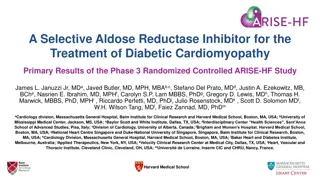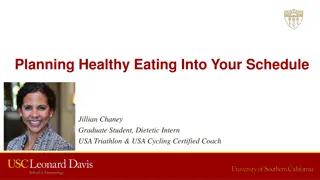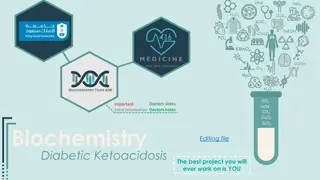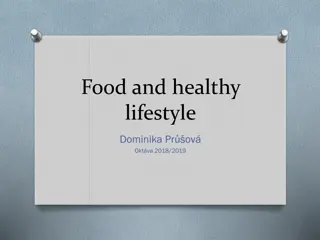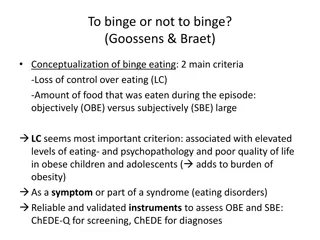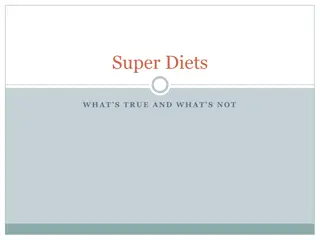Diabetic Diet: Eating Healthy for Better Management
A diabetic diet involves consuming nutrient-rich foods in moderate amounts and adhering to regular meal times. This eating plan focuses on fruits, vegetables, whole grains, and low-fat options while avoiding unhealthy choices. Eating three meals a day at consistent intervals assists in optimal insulin utilization. A registered dietitian can help tailor a diet plan to individual health goals, preferences, and lifestyle. Emphasizing healthy carbohydrates, fiber-rich foods, and portion control are key components of a diabetes-friendly diet.
Download Presentation

Please find below an Image/Link to download the presentation.
The content on the website is provided AS IS for your information and personal use only. It may not be sold, licensed, or shared on other websites without obtaining consent from the author.If you encounter any issues during the download, it is possible that the publisher has removed the file from their server.
You are allowed to download the files provided on this website for personal or commercial use, subject to the condition that they are used lawfully. All files are the property of their respective owners.
The content on the website is provided AS IS for your information and personal use only. It may not be sold, licensed, or shared on other websites without obtaining consent from the author.
E N D
Presentation Transcript
StudyMafia.Org Diabetic Diet Submitted To: Submitted By: Studymafia.org Studymafia.org
Table Contents Definition Introduction About Diabetes Diet Foods To Avoid Creating A Plan Sample of Diabetic Plan Conclusion 2
Definition A diabetes diet simply means eating the healthiest foods in moderate amounts and sticking to regular mealtimes. 3
Introduction A diabetes diet is a healthy-eating plan that's naturally rich in nutrients and low in fat and calories. Key elements are fruits, vegetables and whole grains. In fact, a diabetes diet is the best eating plan for most everyone. 4
About Diabetes Diet A diabetes diet is based on eating three meals a day at regular times. This helps you better use the insulin that your body produces or gets through a medication. A registered dietitian can help you put together a diet based on your health goals, tastes and lifestyle. 6
About Diabetes Diet He or she can also talk with you about how to improve your eating habits, such as choosing portion sizes that suit the needs for your size and activity level. Make your calories count with these nutritious foods. Choose healthy carbohydrates, fiber-rich foods, fish and "good" fats. 7
About Diabetes Diet Healthy carbohydrates During digestion, sugars (simple carbohydrates) and starches (complex carbohydrates) break down into blood glucose. Focus on healthy carbohydrates, such as: Fruits Vegetables Whole grains Legumes, such as beans and peas Low-fat dairy products, such as milk and cheese 8
About Diabetes Diet Fiber-rich foods Dietary fiber includes all parts of plant foods that your body can't digest or absorb. Fiber moderates how your body digests and helps control blood sugar levels. Foods high in fiber include: Vegetables Fruits Nuts Legumes, such as beans and peas Whole grains 9
About Diabetes Diet Heart-healthy fish Eat heart-healthy fish at least twice a week. Fish such as salmon, mackerel, tuna and sardines are rich in omega-3 fatty acids, which may prevent heart disease. Avoid fried fish and fish with high levels of mercury, such as king mackerel. 10
About Diabetes Diet 'Good' fats Foods containing monounsaturated and polyunsaturated fats can help lower your cholesterol levels. These include: Avocados Nuts Canola, olive and peanut oils But don't overdo it, as all fats are high in calories. 11
Foods To Avoid Diabetes increases your risk of heart disease and stroke by accelerating the development of clogged and hardened arteries. Foods containing the following can work against your goal of a heart-healthy diet. Saturated fats: Avoid high-fat dairy products and animal proteins such as butter, beef, hot dogs, sausage and bacon. Also limit coconut and palm kernel oils. 12
Foods To Avoid Trans fats: Avoid trans fats found in processed snacks, baked goods, shortening and stick margarines. Cholesterol: Cholesterol sources include high-fat dairy products and high-fat animal proteins, egg yolks, liver, and other organ meats. Sodium: Aim for less than 2,300 mg of sodium a day. Your doctor may suggest you aim for even less if you have high blood pressure. 13
Creating a Plan Fill half of your plate with nonstarchy vegetables, such as spinach, carrots and tomatoes. Fill a quarter of your plate with a protein, such as tuna, lean pork or chicken. Fill the last quarter with a whole-grain item, such as brown rice, or a starchy vegetable, such as green peas. Include "good" fats such as nuts or avocados in small amounts. Add a serving of fruit or dairy and a drink of water or unsweetened tea or coffee. 14
Creating a Plan Counting carbohydrates Because carbohydrates break down into glucose, they have the greatest impact on your blood glucose level. To help control your blood sugar, you may need to learn to calculate the amount of carbohydrates you are eating so that you can adjust the dose of insulin accordingly. 15
Creating a Plan Choose your foods A dietitian may recommend you choose specific foods to help you plan meals and snacks. You can choose a number of foods from lists including categories such as carbohydrates, proteins and fats. 16
Creating a Plan Glycemic index Some people who have diabetes use the glycemic index to select foods, especially carbohydrates. This method ranks carbohydrate-containing foods based on their effect on blood glucose levels. Talk with your dietitian about whether this method might work for you. 17
Sample of Diabetic Plan Breakfast. Whole-wheat bread (1 medium slice) with 2 teaspoons jelly, 1/2 cup shredded wheat cereal with a cup of 1 percent low-fat milk, a piece of fruit, coffee Lunch. Roast beef sandwich on wheat bread with lettuce, low-fat American cheese, tomato and mayonnaise, medium apple, water Dinner. Salmon, 1 1/2 teaspoons vegetable oil, small baked potato, 1/2 cup carrots, 1/2 cup green beans, medium white dinner roll, unsweetened iced tea, milk Snack. 2 1/2 cups popcorn with 1 1/2 teaspoons margarine 18
Conclusion Embracing your healthy-eating plan is the best way to keep your blood glucose level under control and prevent diabetes complications. And if you need to lose weight, you can tailor it to your specific goals. Aside from managing your diabetes, a diabetes diet offers other benefits, too. 19
References Google.com Wikipedia.org Studymafia.org Slidespanda.com
Thanks To StudyMafia.org


![READ [PDF] Dash diet Cookbook for beginners: 365 days of simple, healthy, low-s](/thumb/2057/read-pdf-dash-diet-cookbook-for-beginners-365-days-of-simple-healthy-low-s.jpg)

